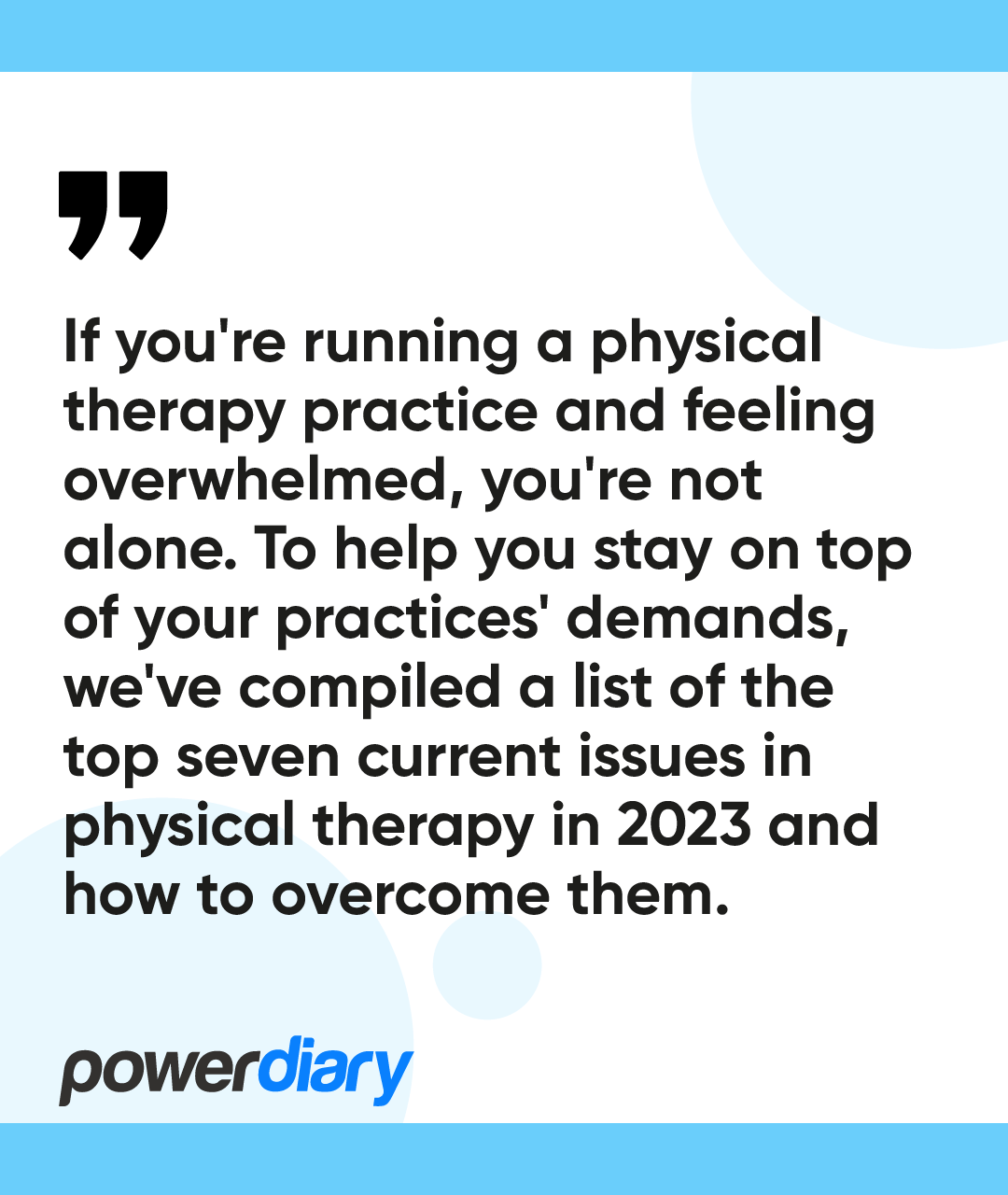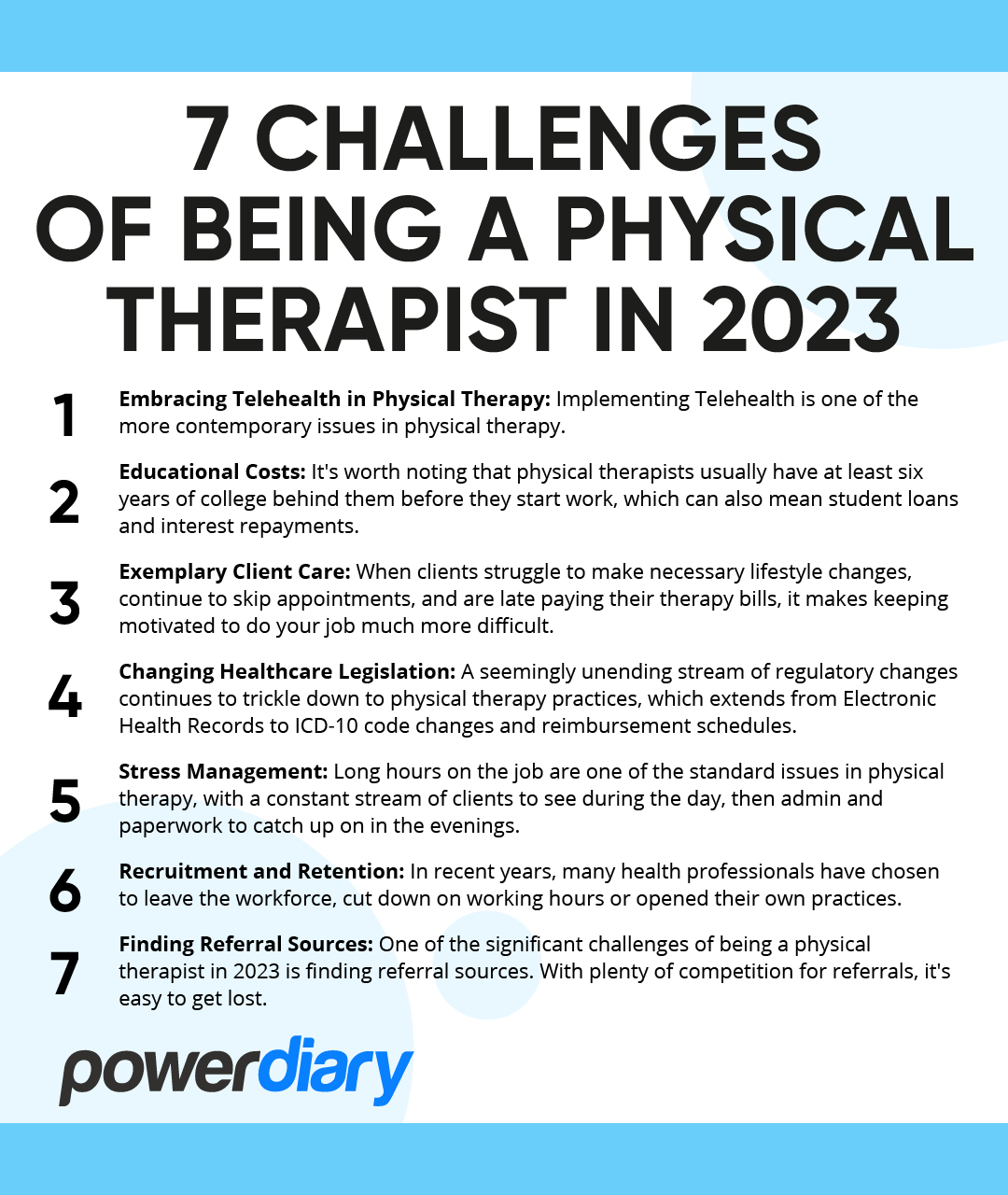Maintaining a thriving physical therapy practice presents its unique set of difficulties. With new treatment methods, regulatory changes, and business models continually appearing, it’s not easy to keep up with the challenges facing a physical therapist.
If you’re running a physical therapy practice and feeling overwhelmed, you’re not alone. To help you stay on top of your practices’ demands, we’ve compiled a list of the top seven current issues in physical therapy in 2023 and how to overcome them.
1. Embracing Telehealth in Physical Therapy
Implementing Telehealth is one of the more contemporary issues in physical therapy. While physical therapy is typically associated with in-person visits for rehabilitation and mobility work, Telehealth has become an increasingly popular option for a variety of therapeutic needs across different sub-specialities. This includes geriatric physical therapy, paediatrics, women’s health, sports medicine, neurological physical therapy, orthopaedic physical therapy and more.
This shift towards digital health solutions has led to significant positive change, including improved access to care and increased patient convenience.
As Telehealth technology advances, some physical therapists choose a hybrid approach as standard, combining traditional methods with digital healthcare solutions.
However, the process of onboarding Telehealth technology and adapting traditional therapy methods comes with challenges. Offering the same level of care via video requires an adapted approach, and both therapists and patients must be comfortable with the technology to benefit from it.
So, what’s the solution?
There will always be a place for in-person appointments in physical therapy. But to compete with other practices, having a well-integrated Telehealth service is increasingly important.
Rather than viewing this as an issue in physical therapy, consider it an opportunity. A well-executed Telehealth service can differentiate you from your competition and provide benefits to patients (such as improved access to care) and your practice (such as reduced appointment no-shows and improved financial performance). Here are a few tips for overcoming Telehealth issues in physical therapy:
- Make use of your practice management software. Starting with Telehealth can be as simple as using the features already integrated into your practice management software. Power Diary, for example, offers two in-platform Telehealth options to meet your business needs.
- Identify appropriate services. Once the technical aspect is taken care of, the focus turns to identifying services that can be effectively delivered through video consultations. This could include guiding patients through remote exercises to aid in recovery from surgery or to manage chronic conditions, encompassing a range of potential outcomes like strengthening, balance, flexibility, and functional mobility exercises.
- Adapt to your patients’ needs. Regardless of the service you offer, ensuring your Telehealth solutions are tailored to your patients’ needs is fundamental. When setting up a Telehealth solution, consider several elements, including patient privacy and security, accessibility for those with disabilities or limited technological capability, clear instructions on accessing video consultations, and ways to integrate video consultations into other service offerings.
2. Educational Costs for Physical Therapists
During their studies, students work hard to understand what the challenges of being a physical therapist are, but the cost of education may be overlooked.
It’s worth noting that physical therapists usually have at least six years of college behind them before they start work, which can also mean student loans and interest repayments. Trying to focus on your career while struggling with debt makes it more difficult to focus on offering your patients the best levels of care. Research by the APTA showed that over 90% of physical therapy graduates have debt over $153,000 (not including mortgage debt) and that the vast majority of the debt is education-related, at around $116,000 on average.
The situation is compounded by physical therapy graduates commonly starting at lower salaries than other healthcare professionals. Then there is the ongoing challenge of staying up-to-date with developments in the industry, which require further education, study and more costs.
So, what’s the solution?
This is more complex and could be a whole article on its own. But here are the main points:
- Read through (and understand) the terms of your contract. Depending on how the loan is structured, you might benefit from paying it off as quickly as possible, but in some cases, there may be a penalty for early repayment.
- Negotiate a good salary. Your salary isn’t set in stone, so do your research before accepting the first job offer that comes your way. It should be related to your level of experience, the value you offer, the job you are employed to do, and the location you will be working in.
- Plan your repayments. You might not be able to change the amount you owe in student loans, but you can review which of your loans should be paid off first, budget your repayments for every month, and set priorities for spending your money. This might mean owning an inexpensive car, renting a smaller apartment, and sticking to lower-cost holidays.
- Pay off more than you need to (and refinance if possible). If you have money left over at the end of the month, put those funds towards your student loans. It might also be possible to refinance your loans at a lower interest rate, which will save you a lot of money over time.
3. Exemplary Patient Care
One of the more surprising challenges of being a physical therapist is keeping your patients on track with their treatments. As a physical therapist, you’re invested in the health and rehabilitation of your patients, and it might even feel that sometimes you care more about their health than they do. When patients struggle to make necessary lifestyle changes, continue to skip appointments, and are late paying their therapy bills, it makes keeping motivated to do your job much more difficult.
According to the Centre of Disease Control and Prevention, over 40% of US adults are obese, and in the UK (25%) and Australia (30%), the numbers are climbing. Recovering from an injury or surgery is difficult without the added limitation of an obese patient. This may make it more challenging for them to complete their at-home exercises, and an in-person session may be more physically demanding for you as the therapist. Also, in many cases, the patient’s weight will make your sessions less effective, causing the patient to attend therapy for longer, incur greater costs, and achieve a less positive outcome.
Add this to a no-show rate of at least 10% and the financial costs, as well as the emotional burden of caring for patients, and it can become overwhelming.
So, what’s the solution?
Take control over what you can influence. You can’t make your patient lose weight, nor can you make them do their at-home exercises or attend the sessions that they book with you, but you can focus on:
- Holistic care. While you’re a physical therapist first and foremost, you’re also a health professional. This means the lines between what is and isn’t your job can become blurred. Rather than taking it all on yourself, prepare a list of resources you can provide patients so they can get specialised professional help for mental and physical concerns outside of your profession.
- Your physical health. Ensure you’re looking after your body to prevent injuries when working with overweight patients.
- Your mental health. If you find the burden of caring for your patients overwhelming, get support from a mental health professional, speak with other physical therapists, and take time for yourself. This may mean doing things you love outside the work context to remind yourself that, although you’re an excellent physical therapist, that’s not all you are.
- Reducing no-shows. This may mean offering visits via Telehealth (which has been proven to reduce no-shows), using appointment reminders, and implementing a no-show policy if you have patients who routinely miss their appointments.
- Managing payments. Billing software will reduce the burden on you as you know that appointments can be accurately invoiced and have the best chance of prompt and full remuneration (either by the patient or a third-party payer). If you feel uncomfortable about billing, remember that if your practice isn’t profitable, you won’t be able to stay open, and you won’t be able to offer assistance to your patients.
- Your team. Encourage, build up, train, and motivate your team to do their best because a team that feels supported and well-led performs better.
4. Changing Healthcare Legislation
One of the most pressing challenges of being a physical therapist is staying up to date with changing legislation. A seemingly unending stream of regulatory changes continues to trickle down to physical therapy practices, which extends from Electronic Health Records to ICD-10 code changes and reimbursement schedules. This makes it harder for practices to stay afloat as they’re held back by red tape. It also makes it more difficult to get reimbursed by third-party payers, as the goalposts keep moving.
So, what’s the solution?
Read, then implement. Our feature article on Medicare Billing Guidelines for Physical Therapy (American Edition), covers the steps you need to take to bill accurately in order to improve your remuneration rates. The American Physical Therapy Association also has a number of resources related to Medicare coding and billing, and Telehealth requirements to support your practice.
5. Stress Management for Physical Therapists
As a physical therapist, you know how important it is to stay fit and active, both for your physical and mental well-being and to be able to do your job well. But long hours on the job are one of the standard issues in physical therapy, with a constant stream of patients to see during the day, then admin and paperwork to catch up on in the evenings. These demands make it difficult to schedule time for yourself and your needs. The ongoing physical exertion of your job may leave you exhausted by the evening and not in the mood to pull on your trainers and run around the block. This becomes more noticeable as you get older when the physical requirements of doing your job begin to take a heavier toll on your health and fitness.
And it’s not just exercise; work-life balance is essential for preventing burnout and reducing stress. Physical therapists, along with most other health professionals, are at risk of burnout and other stress-related conditions. You are charged with the care of patients who often have traumatic injuries, debilitating illnesses, and a negative long-term outlook on a daily basis. Full rehabilitation may not be possible in many cases, so it becomes more about managing quality of life and measuring positive changes in small milestones and minor improvements.
So, what’s the solution?
One of the issues in physical therapy is that it’s physically and emotionally difficult for many – even if you do have a positive attitude to life and your profession. Part of dealing with this challenge is to ensure a good work-life balance, prioritise exercise, seek counselling if needed, and take time to look after yourself.
It’s also important to set up an exercise routine early on in your career when you have fewer responsibilities and more energy. You can experiment to find the best time of day for you to exercise and the type of exercise most suited to your lifestyle and needs. That way, as you progress, you’ll have a routine and discipline in place that you can fall back on when you’re running on empty but still need to take care of yourself.
6. Recruitment and Retention
In recent years, many health professionals have chosen to leave the workforce, cut down on working hours or open their own practices. This trend has disproportionately affected women with the alarming statistic that nearly 3 million women have dropped out of the workforce in America since the COVID-19 pandemic broke out, which has impacted businesses trying to recruit. Considering that over 70% of physical therapists are women, this will continue to be one of the biggest future challenges in physical therapy.
So, what’s the solution?
Read this article that we recently published: 10 Unique Ways to Attract Top Talent and get to work. With ideas ranging from building your reputation to offering internship programs and recruiting recent graduates, there’s a lot you can do to make finding and hiring new team members easier.
7. Physical Therapist’s Referral Sources
One of the significant challenges of being a physical therapist in 2023 is finding referral sources. With plenty of competition for referrals, it’s easy to get lost.
If you’re a new physical therapist, it’s even more difficult. You don’t have contacts and still need to establish a reputation in the community. If you’re an established physical therapist, but you’re struggling to get the referrals you need, then it’s time to work on your referral strategy.
So, what’s the solution?
Building and nurturing referral relationships is a significant step towards growing your practice. When you receive consistent referrals from other healthcare providers, you‘re on the path towards a thriving, sustainable business. But investing in referral relationships requires effort and commitment. If you get it right, however, the payoff is substantial.
Here are a few tips:
- Sort out your website and socials. It’s useful to have some basics in place before you start marketing your clinic for referrals. This includes a functioning website and social media channels, straightforward contact methods, and measures to ensure you don’t miss calls.
- Up your marketing game. Referral marketing is critical for a successful practice as it offers effective and affordable means to maintain these valuable links. We have an insightful Power Talks webinar on “Building and Nurturing Referral Relationships” that offers practical advice on this subject.
- Identify potential referrers. Rather than reaching out to all healthcare practitioners in your area, do your research first. Ensure there is a connection between the referrer’s practice and yours. This approach could extend beyond healthcare practices, considering possibilities like insurance companies, government bodies and community organisations.
- Use Power Diary’s referrer management tools. Power Diary’s referrer management tools makes it easy to keep track of your referrers, so you can properly nurture those valuable relationships.
- Stay connected. Establishing and maintaining meaningful connections is the key to successful referrals. Keep in touch with your referrers by attending events or meetings, staying up-to-date with their practice, and providing regular updates on your own services.
Physical therapy continues to be one of the most rewarding health professions and makes for a satisfying career.
You have the opportunity to help people overcome their physical difficulties and re-integrate into their lives following an injury or chronic condition. That should serve as powerful motivation.
But it’s not all sunshine and roses.
Physical therapy is not without its challenges, and if they aren’t carefully and strategically addressed, they can lead to serious professional and personal consequences.
Luckily, many of them can be addressed with careful, methodical planning. Any remaining issues in physical therapy can often be put into perspective when the broader context of the life-changing work that you do is taken into account.
You play a role in hundreds, if not thousands, of patient success stories and most physical therapists will agree that, in the longer run, the positives count for more than the challenges physical therapists face.
See how Power Diary can empower your physical therapy practice by signing up for a free trial.
*This article was first published in 2020. To keep up with the changing times, we’ve reviewed and updated the major challenges facing physical therapists for 2023.







